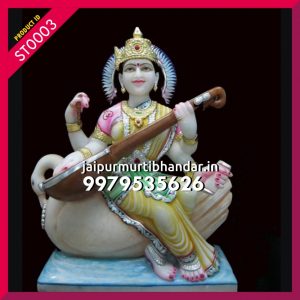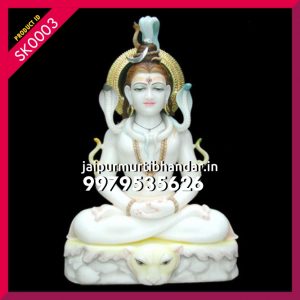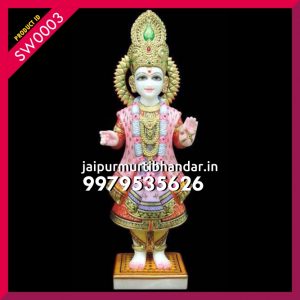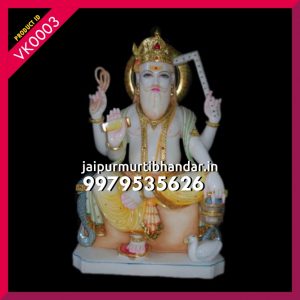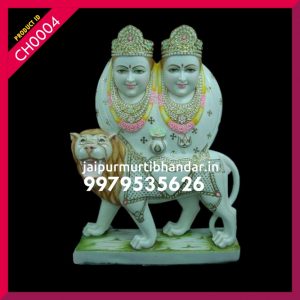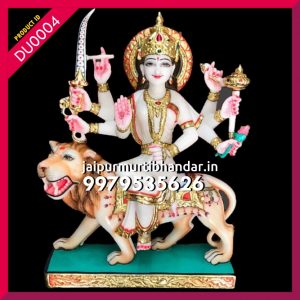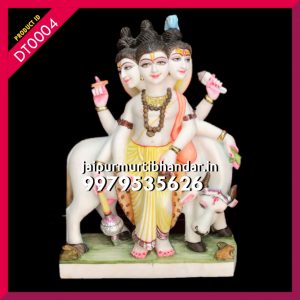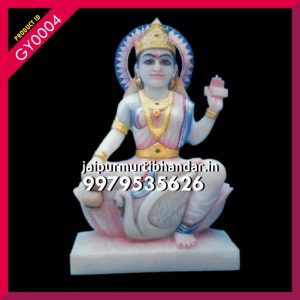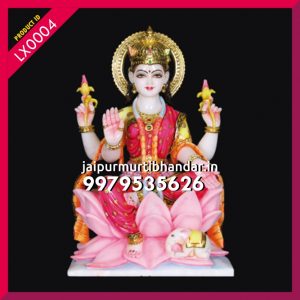-
Saraswati Maa : ST-0001
Saraswati’s name means ‘elegant’, ‘flowing’, and ‘watery’ and this is indicative of her status as one of the early Aryan boundary rivers. The Saraswati River (modern name: Sarsuti), just like the Ganges River, flows from the Himalaya and is considered a sacred source of purification, fertility, and good fortune for those who bathe in her waters. The sacred river, again like the Ganges, then developed into a personified deity.
-
Shankar : SK-0003
In the Hindu mythology, Lord Shiva is the Destroyer and the most important one in the Holy Trinity, the other two being Brahma the Creator and Vishnu the Protector. Lord Shiva has always fascinated his followers by his unique appearance: he has not two but three eyes, has ash smeared all over his body, has snakes coiled up around his head and arms, wears tiger and elephant skin, leads a wild life in the cremation grounds far removed from social pretenses, and is known for his proverbial anger..
-
Shivling: SV-0003
We are engaged in exporting the Marble Shivling God. Considering the spiritual value attached to it, we offer our client various kind of Marble Shivling. The ultimate finishing work, perfect cutting and dimensional accuracy offer superb quality statue. Our quality controllers check the product before the final dispatch in the market.
-
Shrinath Ji : SH-0003
Shrinathji?s idol was brought to Rajasthan from Govardhana near Vrindavan to protect it from the hands of the Mughal emperor Aurangzeb who in 1665 was bent upon vandalizing the area of Vrindavan by widespread destruction of Hindu temples. When the Mughal army came to Govardhana, the devotees of the Lord showed them the titles and gifts given to the temple by the previous Mughal rulers. The army commander then ordered the deity to be taken away from Govardhana. For almost six months the statue stayed in Agra after which the custodians of the idol of Shrinathji left that place with the idol in search of a new heaven.
-
Swaminarayan : SW-0003
The Swaminarayan Sampraday began as the Uddhav Sampraday and was led by Ramanand Swami. In 1799, Swaminarayan, born as Ghanshyam Pande, was initiated into the Uddhav Sampraday as an ascetic (Sadhu) by his guru, Ramanand Swami, and given the name “Sahajanand Swami”. At the age of 21, Neelkanth Varni was given the leadership of the sect known as Uddhav Sampraday with the blessings of Ramanand Swami, who handed him control of the religious diocese shortly before his death. Fourteen days after Ramanand Swami died, Neelkanth Varni, now known as Sahajanand Swami, held a large gathering of followers at the town of Faneni. It was during this meeting that Swaminarayan introduced what he termed “the father of all Mantras” and described it as “maha” (or great).[8] Then he was known as Swaminarayan, and the name “Swaminarayan Sampraday” came into existence.
At the age of 49, Swaminarayan took Samadhi at Gadhada in 1830 and died, after he promised to remain within the Swaminarayan Sampraday in the images he installed (and by the Acharyas succeeding him), the Acharyas and saints installed by him (and those in direct succession), the saints he initiated (and those initiated by succeeding Acharyas) and the scriptures, such as Shikshapatri, Vachanamrut, Satsangi Jeevan, Nishkhulanand Kavya and Yamdand (and those authorised by succeeding Acharyas).
-
Vishvakarma : VK-0003
Vishvakarma (Sanskrit for “all-accomplishing, maker of all, all-doer”) is personification of creation and the abstract form of the creator God according to the Rigveda. He is the presiding deity of all Vishwakarma (caste), engineers, artisans and architects.He is believed to be the “Principal Architect of the Universe “, and the root concept of the later Upanishadic figures of Brahman and Purusha.
He is mentioned as the son of K??yapa and Aditi and is said to have made the three worlds with pieces of the Sun god, Surya.
-
Chotila Maa: CH-0004
Chamunda Mata is when the two demons named 'Chanda' and 'Munda' good for the road for many years thanks to the Lord Brahma. Brahma was pleased when he appeared before them and asked the demons warriors strong and dominate the world and into the sky. Brahma was merciful wish.There granted to the chaos of the world and demons became very greedy and tried to revive the sky and the three houses of Vishnu (Vaikuntha), Shiva (Kailas) and Brahma (Brahmaloka). Three gods went to the mother goddess Parvati who took the form of Chandi and Chamunda who murdered Chand mund.
-
Durga Maa: DU-0004
Goddess Durga a super powerful deity ? Shakti? in Hindu mythology is worship in various forms corresponding to her to aspects benevolence and fierceness. She is Uma, “glow”; Gauri, “white or brilliant”; Parvati, “the mountaineer”; and Jagatmata, “the-mother-of-the-world” in her milder guise The terrible appearance are Durga “the inaccessible”; Kali, “the black”; Chandi, “the fierce”; and Bhairavi, “the terrible.”
Durga, a gorgeous warrior riding upon a tiger or Lion. Devi Durga with a lion in a fearless pose is known of “Abhay Mudra”, signifying assurance of freedom from fear. The universal mother seems to be saying to all her devotees: “Surrender all actions and duties onto me and I shall lift you from your all troubles “.
-
Dutt -DT0004
Shri Guru Dattatreya or Shri Datta Guru is Hindu deity (Ishta Devata) encompassing the trinity of Brahma, Vishnu and Shiva, collectively known as Trimurti. The name Dattatreya can be divided into two words – “Datta” (meaning given) and “Atreya” means, in Sanskrit, “son of Athri”. Athri is one of the 7 seers / principles of creation. Athri also means in Sanskrit “not three”. The one who came down from that which is not three is called Athreya. Dattatreya is also a combination of ?Datta? and ?treya? – Treya being the trinity ? Bramha (creator), Vishnu (preserver) and Shiva (destroyer).
In the Nath tradition Dattatreya is recognized as an Avatar or incarnation of the Lord Vishnu and as the Adi-Guru (first teacher) of the Adinath Sampradaya of the Naths. Dattatreya is primal manifestation in the Guru tradition (Supreme Guru principal). Dattatreya is considered to be the presiding deity (Ishta Devata) for the path of yoga ? therefore called as “Lord of Yoga”.
Shri Dattatreya is also known by another equally popular name of ?Avadhut?. Avadhut is one who washes away the temperamental defects i.e. the three qualities or Trigunas ? Sattva (Purity and Knowledge) Raja (Activity and Passion), Tama (Ignorance and Inertia). He destroys Trigunas. He bestows the spiritual experience of the unmanifest principle. Importance of Lord Datta from the seekers point of view is – There are many deities (Ishta Devatas or Ishvara) in Hindu religion, but there is only who is worshipped in the form of a Guru ? and he is Lord Datta. Hence the extolling (Jai-ghosh) of ?Avadhut Chintana Jai Gurudev Datta?. Shri Datta Guru is the ideal of the Guru principle and a proponent of Yoga.
-
Gayatri Maa: GY-0004
Gayatri Devi is an incarnation of Saraswati Devi, consort of Lord Brahma, symbolising the “shakti” (strength) and “dev” (quality) of Knowledge, Purity and Virtue. Saraswati Devi is held to be the patronness of the Arts, being a poet and musician, as well as skillful composer. In the form of Gayatri Devi, with the blessings of Lord Brahma, she is believed to have given the four Vedas to mankind.
Goddess Gayatri
Gayatri is depicted seated on a lotus. She is depicted with five faces representing the pancha pranas /pancha vayus(five lives/winds): prana, apana,vyana, udana, samana, of the five principles/ elements (pancha tatwas) earth, water, air, fire, sky (prithvi, jala, vayu, teja, aakasha). She has 10 hands carrying the five ayudhas: shankha; chakra, kamala, varada, abhaya, kasha, ankusha, ujjwala utensil, rudrakshi mala. -
Khodiyar Maa: KH-0004
Khodiar Mata is the revered Goddess, who is worshiped by many sects of the Hindu faith. Elaborate statues of this deity can be availed from us at exceptionally affordable prices. These statues are polished with fine material, which has a lasting finish. Furthermore, our range of statues is a true representation of our cultural heritage.
-
Laxmi Maa : LX-0004
Lakshmi is also called Sri or Thirumagal because she is endowed with six auspicious and divine qualities, or gunas, and is the divine strength of Vishnu. In Hindu religion, she was born from the churning of the primordial ocean (Samudra manthan) and she chose Vishnu as her eternal consort.When Vishnu descended on the Earth as the avatars Rama and Krishna, Lakshmi descended as his respective consort.In the ancient scriptures of India, all women are declared to be embodiments of Lakshmi.The marriage and relationship between Lakshmi and Vishnu as wife and husband is the paradigm for rituals and ceremonies for the bride and groom in Hindu weddings. Lakshmi is considered another aspect of the same supreme goddess principle in the Shaktism tradition of Hinduism
Lakshmi is depicted in Indian art as an elegantly dressed, prosperity-showering golden-coloured woman with an owl as her vehicle, signifying the importance of economic activity in maintenance of life, her ability to move, work and prevail in confusing darkness.She typically stands or sits like a yogin on a lotus pedestal and holds lotus in her hand, a symbolism for fortune, self-knowledge and spiritual liberation.Her iconography shows her with four hands, which represent the four goals of human life considered important to the Hindu way of life: dharma, k?ma, artha, and moksha.

 +91 9979 535 626
+91 9979 535 626